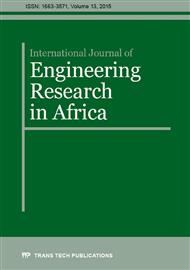[1]
Wang Dian-hai. Traffic flow theory [M]. Beijing: China Communications Press, 2002.
Google Scholar
[2]
Backstone M, Mcdonald. Car-following: A historical review [J]. Transportation Research Part F.1999, 2(4):181-196.
Google Scholar
[3]
Newell G F. Memoirs on highway traffic flow theory in the 1950s [J]. Operations Research, 2002, 50(1):173-178.
DOI: 10.1287/opre.50.1.173.17802
Google Scholar
[4]
He Min, Liu Xiao-ming, Rong Jian. Research Progress of Traffic Flow Car Following Model [J]. Chinese Ergonomics, 2000, 6(2):46-50.
Google Scholar
[5]
Jin Chun-xiao, Wang Hui. Car-following Model and Its Stability Analysis [J]. Journal of Engineering and Information, 2001, 1(3):220-225.
Google Scholar
[6]
Helbing D. Traffic and Related Self-driven Many particle System [J].Reviews of Modern Physics,2001, 73 (4):1067-1141.
DOI: 10.1103/revmodphys.73.1067
Google Scholar
[7]
Zhang Zhi-yong, Rong Jian, Ren Fu-tian. Review of Car-following Research [J]. Journal of Highway and Transportation Research and Development, 2004, 21(8): 108-113.
Google Scholar
[8]
E. Kometani, T. Sasaki. On the stability of traffic flow[J]. Journal of Operations Research Japan, 1958, 2(1):11-26.
Google Scholar
[9]
P. G. Gipps. A behavioral car following model for computer simulation[J]. Transportation Research, Part B,1981, 15(2):105-111.
DOI: 10.1016/0191-2615(81)90037-0
Google Scholar
[10]
Nagel K, Schreckenberg M. A Cellular automation model for freeway traffic [J]. J Phys I, 1992, 2:2221-2229.
Google Scholar
[11]
Van Winsum W. The human element in car following models [J]. Transportation Research Part F, 1999, 2:207-211.
DOI: 10.1016/s1369-8478(00)00008-5
Google Scholar
[12]
Wang Dian-hai. Jin Sheng. Review and outlook of Modeling of Car Following Behavior [J]. China Journal of Highway and Transport, 2012, 25(1):115-127.
Google Scholar
[13]
Sheng Jin, Wang Dian-hai. Car Following Model and Simulation Considering Front Traffic Situation[J]. Journal of Beijing Polytechnic University, 2012, 38(8): 1236-1241.
Google Scholar
[14]
Chakroborty P, Agrawal S, Vasishtha K. Microscopic modeling of driver behavior in uninterrupted [J]. Journal of Transportation Engineering, 2004,130(4): 438-451.
DOI: 10.1061/(asce)0733-947x(2004)130:4(438)
Google Scholar
[15]
Gunay B. Car following theory with lateral discomfort [J]. Transportation Research Part B, 2007, 41:722-735.
DOI: 10.1016/j.trb.2007.02.002
Google Scholar
[16]
Jin Sheng, Wang Dian-hai, Xu Cheng et al. Staggered car-following induced by lateral separation effects in traffic flow[J]. Physics Letters A, 376(3), 2012, 153-157.
DOI: 10.1016/j.physleta.2011.11.005
Google Scholar
[17]
Taragin A. Driver behavior as affected by objects on highway shoulders [J]. Highway Research Board, 34, 453-472.
Google Scholar
[18]
Hu Sangen. Research on Automobile Anti-collision Alarming System Based on SPCE061A [D]. Guangzhou: South China University of Technology, 2013.
Google Scholar
[19]
Yang Tao,Song Dan-dan. Safe Speed of Automobile Rapid Steering [J]. Communications Standardization, 2009, 9(204):100-103.
Google Scholar
[20]
He Zhaocheng, Sun Wenbo. A new car-following model considering lateral separation and overtaking expectation [J]. Acta Phys. Sin., 2013, 10(62):108901-1-108901-9.
DOI: 10.7498/aps.62.108901
Google Scholar


